

Technology Proof of Concept Sample. ADempiere. Jump to Navigation Home ADempiere Business Suite is an industrial strength open-source software solution that combines ERP, CRM and SCM support for business process.

ADempiere provides a framework for extending and customizing to meet business needs. To download, click on "Adempiere better than free beer. " (see image above) Check'em out: Catura | XianCaro | Joerg Viola | Praneet Tiwari | Hengsin | Xiaomj | Stefan Kuthan | Rob Klein | Jeff Davis | Posterita | Berrita | CarlosRuiz | Red1 You can help by contributing Webmistress: Jireh Arciaga. Adempiere. ADempiere /ˌɑːdɛmˈpjɛreɪ/ is an Enterprise Resource Planning or ERP software package released under a free software license.

The word ADempiere in Italian means "to fulfill" or "to accomplish".[1] The software is licensed under the GNU General Public License.[2] History[edit] Goals of this project[edit] The goal of the Adempiere project is the creation of a community-developed and supported open source business solution.[6] The Adempiere community follows the open-source model of the Bazaar described in Eric Raymond's article The Cathedral and the Bazaar. Business functionality[edit] The following business areas are addressed by the Adempiere application: Enterprise Resource Planning (ERP)Supply Chain Management (SCM)Customer Relationship Management (CRM)Financial Performance AnalysisIntegrated Point of sale (POS) solutionIntegrated Web storeMaterial Requirements Planning (or Manufacturing Resource Planning, in beta for Release 3.5), contributed by the Libero project.[7] Technology[edit] Notes.
Dolibarr ERP & CRM Open Source software. Guidance for Proof of Concept Pilot. (PDF Version Available) Recommended Practice: Developing and Implementing an Enterprise-wide ElectronicRecords Management (ERM) Proof of Concept Pilot.
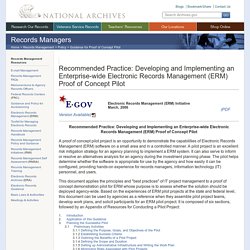
12 Steps to a Successful Proof of Concept - Part 3 by Andy Piper. This series of articles is designed to give you a repeatable process for installing a proof of concept at a customer site in a manner that leads to a successful product evaluation and ultimately a sale.
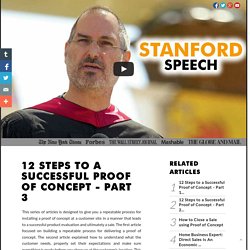
The first article focused on building a repeatable process for delivering a proof of concept. The second article explained how to understand what the customer needs, properly set their expectations and make sure everything is ready before you show up at the customer’s location. This article explains what to do during and after the customer visit to ensure a successful installation and keep the sales process moving forward. Steps for a Successful Proof of Concept - Adaptiva. As part of the evaluation process, you should have had a demonstration of the product and have a pretty good understanding of what it can do, what it can’t do and what problems it will solve.
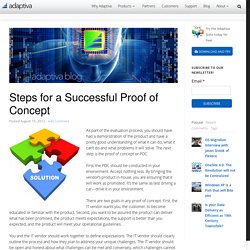
The next step is the proof of concept or POC. First, the POC should be conducted in your environment. Accept nothing less. By bringing the vendor’s product in-house, you are ensuring that it will work as promoted. It’s the same as test driving a car—drive it in your environment. 12 Steps to a Successful Proof of Concept - Part 1 by Andy Piper. There are two parts to every business.
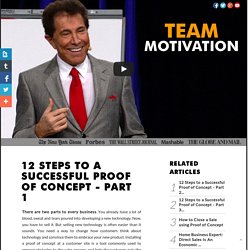
You already have a lot of blood, sweat and tears poured into developing a new technology. Now, you have to sell it. But selling new technology is often easier than it sounds. You need a way to change how customers think about technology and convince them to embrace your new product. 12 Steps to a Successful Proof of Concept - Part 2 by Andy Piper. In the first article of this series, I discussed the importance of the proof of concept in the sales process.
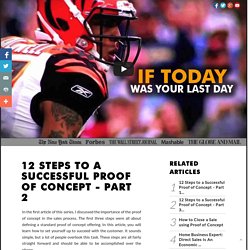
The first three steps were all about defining a standard proof of concept offering. In this article, you will learn how to set yourself up to succeed with the customer. It sounds simple, but a lot of people overlook this task. These steps are all fairly straight forward and should be able to be accomplished over the phone. Step 4: Identify Unique Customer Challenges. The Proof of Concept Pilot methodology of ERP selection. Are you concerned you may select the wrong ERP system?

The Proof of Concept Pilot methodology of ERP selection will ensure the right system, the first time. The usual steps within the "Historical Selection Method" 1. Document a detailed list of all company requirements2. An example of a successful proof of concept - ETL Solutions. In software development, a proof of concept can be a vital tool to demonstrate the software’s capabilities and its fit with the client’s requirements.
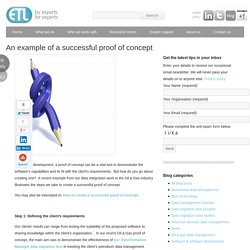
But how do you go about creating one? A recent example from our data integration work in the Oil & Gas industry illustrates the steps we take to create a successful proof of concept. You may also be interested in: How to create a successful proof of concept. Step 1: Defining the client’s requirements Our clients’ needs can range from testing the suitability of the proposed software to sharing knowledge within the client’s organisation. In our example, there were two types of files - LAS and DLIS – to migrate in the context of the PPDM and WITSML industry standards.
Embed transforms within near real-time message handling, particularly WITSMLData migration converting to LAS files to and from the client’s PPDM-based systemData migration converting to DLIS files to and from the client’s PPDM-based system. Step 2: Defining the client’s input. What is a Proof of Concept (POC)? - Definition from Techopedia. Proof of concept is a term with various interpretations in different areas.

POC in software development describes distinct processes with different objectives and participant roles. POC may also refer to partial solutions involving a small number of users acting in business roles to establish whether a system satisfies certain requirements. The overall objective of POC is to find solutions to technical problems, such as how systems can be integrated or throughput can be achieved through a given configuration. In the business world, POC is how startups demonstrate that a product is financially viable. POC involves extensive research and review and is submitted as a single package to concerned parties. POC in digital arts and short films or animations requires making minimalist prototypes to determine whether a device works properly and is viable. What is proof of concept? Building Your Cloud Infrastructure: Scenario Overview. Published: February 29, 2012 Updated: September 19, 2012 Applies To: Windows Server 2012 An overview of the process for building your cloud infrastructure in Windows Server® 2012 for building an infrastructure for public and private clouds, including a scenario description, its practical applications, the roles and services that enable it, and links to topics that describe how to deploy it.
Did you mean… The process for building your cloud infrastructure uses a combination of Hyper-V, failover clustering, storage, and networking technologies to more easily create a Microsoft cloud infrastructure. Building a cloud infrastructure with Windows Server 2012 is much easier than previous versions of Windows Server because of built-in support for the following: Multi-tenancyDesigning a data center for dynamic and automatic placement of virtual machines is not enough, especially when you are serving more than one customer.